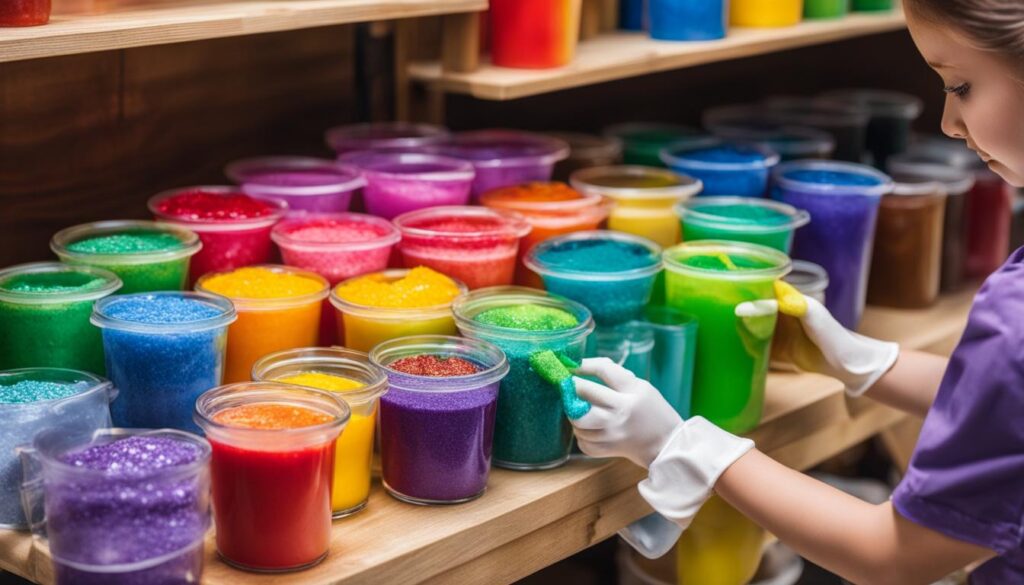

Making slime at home is a fun and creative activity that can also be turned into a profitable business. With the right ingredients and recipe, you can create amazing stretchy and oozing slime. In this article, I will guide you through the process of making homemade slime and provide tips for starting your own slime shop at home. Whether you are a slime enthusiast looking to share your creations or an entrepreneur seeking a new venture, this article is for you.
Key Takeaways:
- Homemade slime is a fun and creative activity that can be turned into a profitable business.
- Follow a specific slime recipe and use the right ingredients for successful slime making.
- Starting a slime business requires planning, marketing, and understanding your target audience.
- Slime making is a science-based activity that can educate and entertain both kids and adults.
- Proper storage and maintenance are important to ensure the longevity of your slime products.
Section 2: The Ingredients for Homemade Slime
When it comes to making homemade slime, having the right ingredients is essential. Each component plays a specific role in creating the perfect slime texture and consistency. Here are the key ingredients you’ll need:
- White or Clear PVA School Glue: This is the base of your slime and provides the stretchy and gooey texture.
- Water: Water is used to dilute the glue and make it easier to mix.
- Slime Activator: This is what triggers the chemical reaction that turns the glue into slime. Common slime activators include borax, sodium borate, or boric acid.
- Shaving Foam: Adding shaving foam to your slime recipe creates a fluffy and cloud-like texture.
- Mix-Ins: Get creative with mix-ins like food coloring, glitter, or confetti to give your slime a unique look and feel.
It’s important to follow the recipe and not make substitutions when it comes to slime ingredients. The chemistry behind slime-making relies on specific reactions, so any changes can affect the final result. Also, remember to prioritize safety by washing your hands thoroughly after playing with slime and handling the ingredients carefully.
Now, let’s take a closer look at the measurements and instructions for making homemade slime:
| Ingredients | Measurements |
|---|---|
| PVA Glue | 1/2 cup |
| Water | 1/4 cup |
| Slime Activator | 1/4 teaspoon (diluted in 1/4 cup of water) |
| Shaving Foam | A few squirts for desired texture |
| Mix-Ins | As desired |
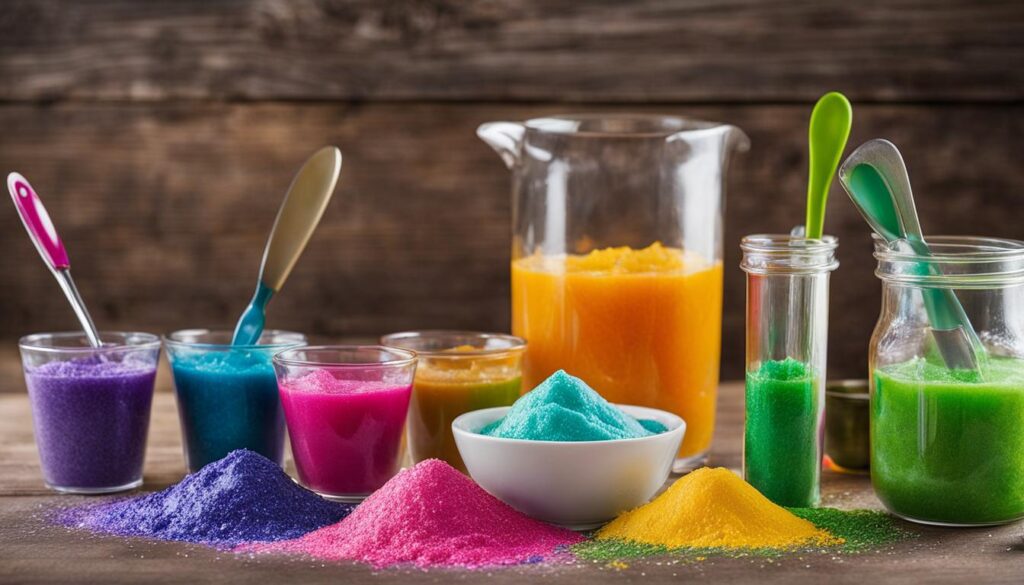

“Making homemade slime is a fun and creative activity that allows you to customize your slime to your liking. Get creative with colors, textures, and even scents to make your slime truly unique!”
Section 3: The Recipe for Homemade Slime
Making homemade slime is an exciting and creative activity that anyone can enjoy. With just a few simple ingredients and steps, you can create your very own slime at home. Follow this easy slime recipe to get started:
Ingredients:
- 1 cup of white or clear PVA school glue
- 1 cup of water
- 1 teaspoon of borax (slime activator)
- Optional mix-ins: food coloring, glitter, confetti
Instructions:
- In a mixing bowl, pour 1 cup of glue.
- Add 1 cup of water to the glue and mix well.
- In a separate container, dissolve 1 teaspoon of borax in 1 cup of warm water.
- Slowly pour the borax solution into the glue mixture while stirring continuously.
- Continue stirring until the slime starts to form and pull away from the sides of the bowl.
- Knead the slime with your hands until it reaches the desired consistency.
- If desired, add food coloring, glitter, or confetti to customize your slime.
Remember, making slime is a hands-on process, so don’t be afraid to get messy and have fun with it! Experiment with different colors and mix-ins to create unique slime creations.
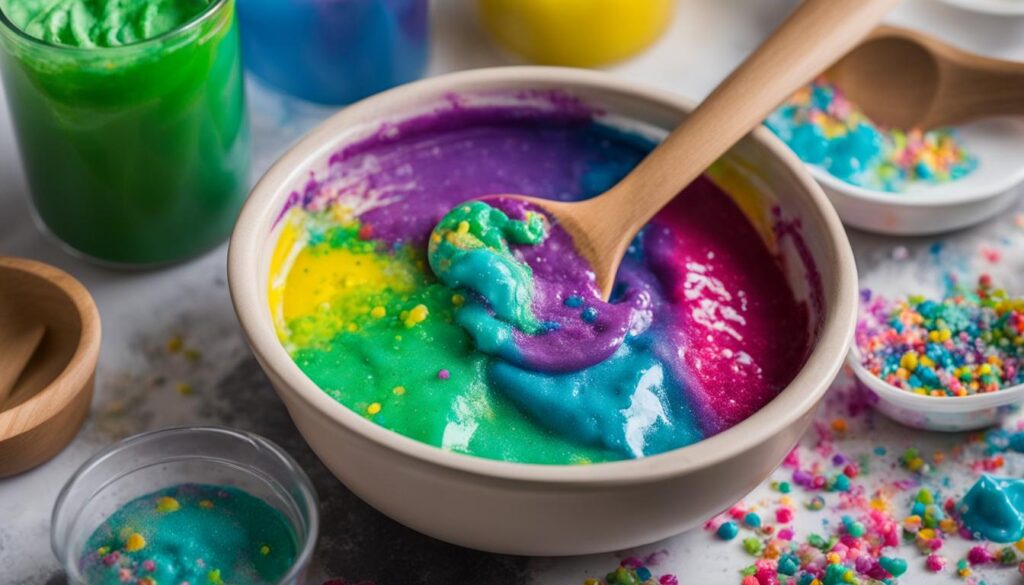

Troubleshooting Tips:
If your slime is too sticky, add a small amount of borax solution and continue kneading until it becomes less sticky. If it’s too stiff, add a few drops of water and knead until it becomes more pliable. Adjust the quantities of glue and borax solution according to your desired slime consistency.
Once you have made your slime, remember to store it properly in a sealed container to prevent drying out. Enjoy the endless hours of sensory play and creative fun that homemade slime provides!
Tips for Starting a Slime Business
Starting a slime business can be an exciting and rewarding venture. Whether you’re a slime enthusiast or an aspiring entrepreneur, turning your love for slime into a profitable business requires careful planning and execution. Here are some tips and tricks to help you get started:
1. Define Your Niche
Before launching your slime business, it’s important to define your niche. Determine what sets your slime products apart from others in the market. Do you specialize in a specific type of slime, such as fluffy slime or clear glue slime? Are your products scented or themed? Identifying your unique selling points will help you target your audience and stand out from the competition.
2. Create a Solid Business Plan
Every successful business starts with a well-crafted business plan. Outline your goals, target market, pricing strategy, marketing plan, and financial projections. A comprehensive business plan will serve as your roadmap and help you stay focused and organized as you grow your slime business.
3. Build an Engaging Brand
An engaging brand is crucial in attracting customers and building a loyal following. Develop a catchy and memorable brand name, logo, and tagline that reflect the personality of your slime products. Create a visually appealing website or online store to showcase your slime collection and provide a seamless shopping experience for customers. Leverage social media platforms to share behind-the-scenes footage, customer testimonials, and engaging content to build an online community around your brand.
4. Source Quality Ingredients
The quality of your slime products is essential for customer satisfaction and repeat business. Source high-quality ingredients to ensure that your slime is stretchy, non-sticky, and long-lasting. Consider partnering with reputable suppliers or manufacturers who can provide consistent and reliable ingredients for your slime creations.
5. Provide Excellent Customer Service
Delivering exceptional customer service is key to building a loyal customer base. Respond promptly to customer inquiries and address any concerns or issues with professionalism and empathy. Provide clear and detailed product descriptions, including ingredients and safety information, to instill confidence in your customers. Consider offering personalized packaging or thank-you notes to leave a lasting impression.
By following these tips and tricks, you’ll be well on your way to starting a successful slime business. Remember to stay creative, adaptable, and passionate about your products, and you’ll attract slime enthusiasts from all around.
The Science Behind Slime Making
Making slime is not just a fun and gooey activity; it’s also an opportunity to delve into the fascinating world of science. Understanding the chemistry behind slime can help you create the perfect stretchy and oozing concoction. Let’s take a closer look at the science of slime and the chemical reactions at play.
Slime making relies on a process called cross-linking, where the molecules of the slime ingredients join together to form a polymer network. The main component of slime is the PVA (polyvinyl alcohol) glue, which contains long chains of molecules. These chains can slide past each other, giving the glue its liquid-like properties.
When a slime activator, such as borax or sodium borate, is added to the glue, it reacts with the PVA molecules. This reaction causes the chains to become intertwined, forming a network that traps the liquid while still allowing it to flow. This cross-linking process gives slime its unique stretchy and elastic texture.
Another key ingredient in slime making is shaving foam. When added to the glue and activator mixture, it creates tiny air bubbles throughout the slime, giving it a fluffy and light texture. The addition of various mix-ins like food coloring, glitter, and confetti adds visual interest and enhances the sensory experience of playing with slime.
Table: Chemical Reactions in Slime Making
| Ingredients | Role | Chemical Reaction |
|---|---|---|
| PVA Glue | Main component | Forms long chains of molecules |
| Slime Activator (borax, sodium borate) | Triggers cross-linking | Reacts with PVA molecules to create polymer network |
| Shaving Foam | Creates fluffy texture | Adds air bubbles to the slime |
| Mix-ins (food coloring, glitter, confetti) | Enhances visual interest | No specific reactions, purely visual and sensory |
By understanding the science of slime making, you can experiment with different ratios and ingredients to create your own unique slime recipes. Whether you’re a curious scientist or simply enjoy the squishy fun of slime, exploring the chemistry behind it adds another layer of excitement to this popular DIY activity.
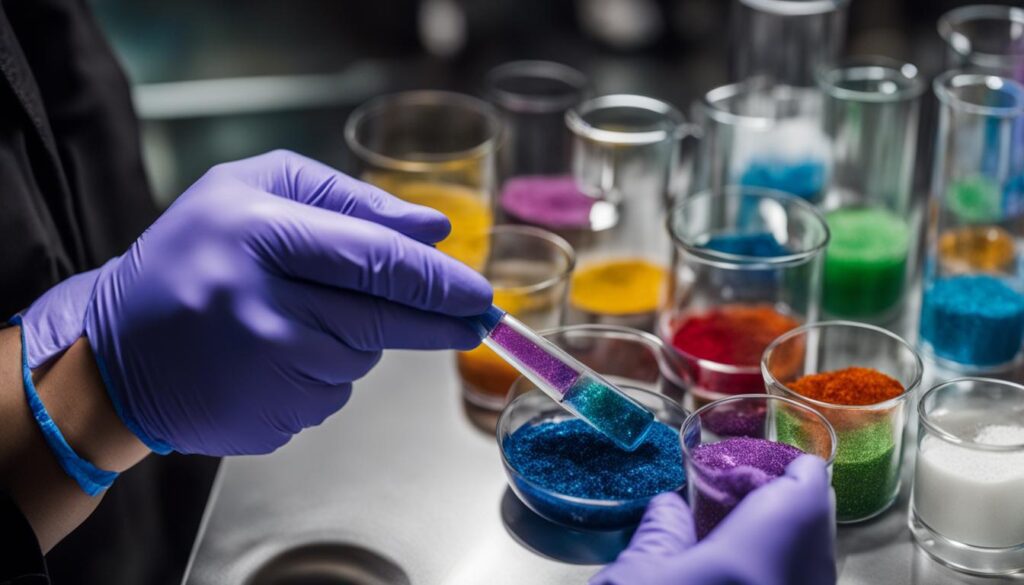

The Science of Slime: Understanding Slime Storage and Maintenance
As slime enthusiasts, we know that creating the perfect slime is only the first step. To ensure the longevity and enjoyment of your slime products, proper storage and maintenance are key. In this section, I will guide you through the best practices for slime storage, container options, and essential maintenance tips.
Slime Storage
The storage of slime plays a crucial role in maintaining its texture and preventing contamination. When storing your slime, it is important to keep it in a sealed container to prevent drying out or exposure to dust and debris. Deli-style containers or mason jars with lids are ideal for slime storage, as they provide an airtight seal. Remember to label your containers with the name and date of creation to keep track of freshness.
It is also essential to store your slime in a cool and dry place. Extreme temperatures can affect the consistency and shelf life of slime. Avoid storing slime in direct sunlight or areas with high humidity, as this can cause the slime to become sticky or moldy. By following these storage guidelines, you can ensure that your slime remains in its best condition for a longer period of time.
Proper Container Options
When it comes to slime containers, different options have their advantages. Deli-style containers, as mentioned earlier, are popular for their airtight seal and easy stacking. They come in various sizes, allowing you to store different amounts of slime. Mason jars are also a great choice, providing a vintage and aesthetic appeal. These containers can be decorated with ribbons or labels for a personalized touch.
For slime entrepreneurs or those who want to gift their creations, consider packaging options that showcase your slime. Clear plastic containers can offer a visually appealing display, allowing customers or recipients to see the colors and textures of the slime. Additionally, if you plan to sell your slime online or at fairs, consider packaging it in resealable bags for convenient transportation and storage.
Slime Maintenance Tips
To keep your slime products in top condition, it is important to provide proper care instructions to customers and users. Advise them to use clean and dry hands when handling slime to prevent contamination. Remind them to avoid exposing the slime to rough surfaces or pulling it apart forcefully, as this can cause the slime to break or lose its stretchiness.
Regularly inspect your slime for any signs of damage or deterioration. If you notice any changes in texture, smell, or appearance, it is best to discard the slime and make a fresh batch. By staying vigilant and practicing regular slime maintenance, you can ensure a satisfying slime experience every time.
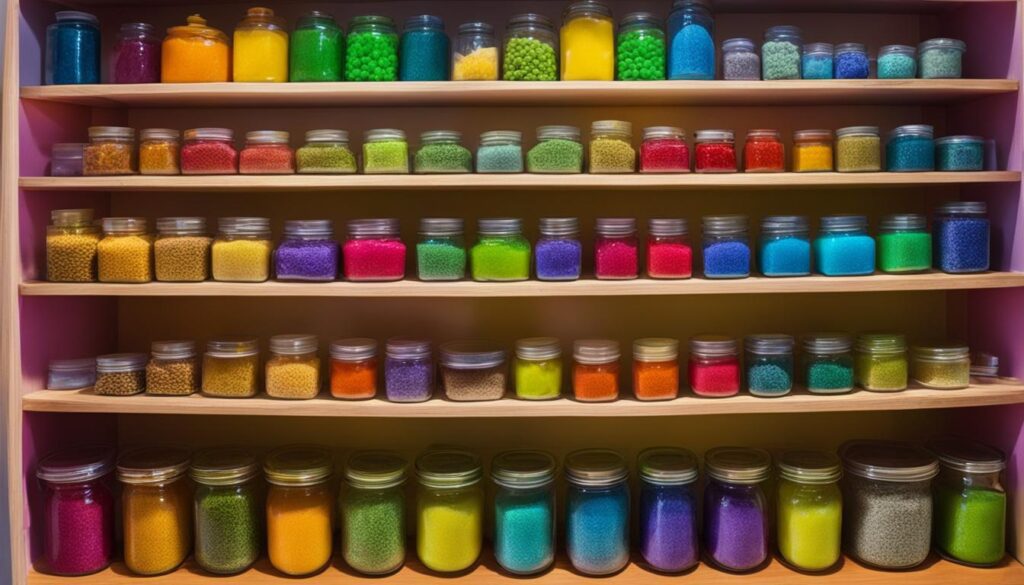

In conclusion, proper slime storage and maintenance are essential for preserving the quality and longevity of your slime. By following these guidelines and investing in suitable containers, you can enjoy your slime creations for an extended period of time. Remember to provide clear care instructions to customers and users to ensure their continued satisfaction. Now that you know the science behind slime storage, it’s time to put it into practice and keep your slime collection in pristine condition!
Explore Different Slime Variations
The world of slime offers endless possibilities for creativity and exploration. Once you have mastered the basic slime recipe, you can experiment with various variations. Some popular options include:
Fluffy Slime:
Fluffy slime is made with the addition of shaving cream, which gives it a light and airy texture. This variation is perfect for those who enjoy a softer and more squishy slime experience.
Clear Glue Slime or Liquid Glass Slime:
Clear glue slime, also known as liquid glass slime, creates a transparent and glossy appearance. This type of slime is visually stunning and provides a unique sensory experience.
Clay Slime:
If you prefer a slime with a soft and moldable texture, clay slime is a great option. Adding clay to your slime mixture gives it a fun and playful consistency that can be shaped and molded into different designs.
Glitter Glue Slime:
To add some sparkle and fun to your slime, try making glitter glue slime. By using glitter glue as the base, you can create a slime that shimmers and shines, making it a favorite among slime enthusiasts of all ages.
Don’t be afraid to get creative and try new ingredients and techniques when making slime. The possibilities are endless, and you might just discover your own unique variation that becomes a hit with slime lovers everywhere!
